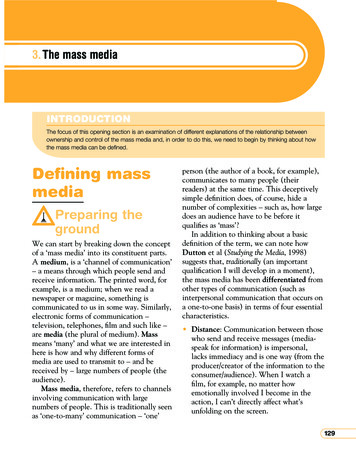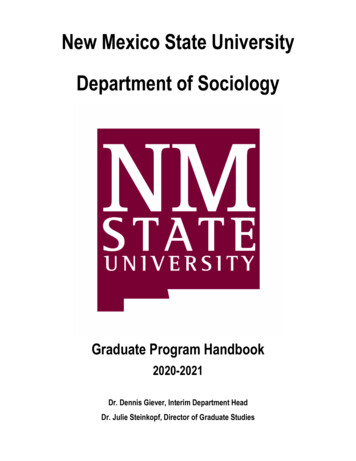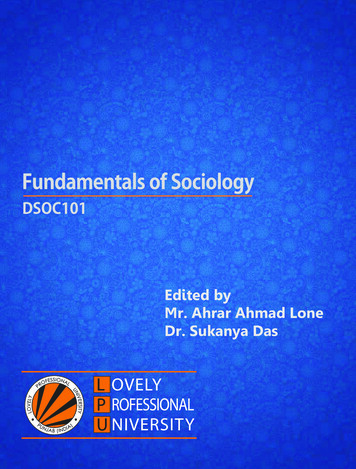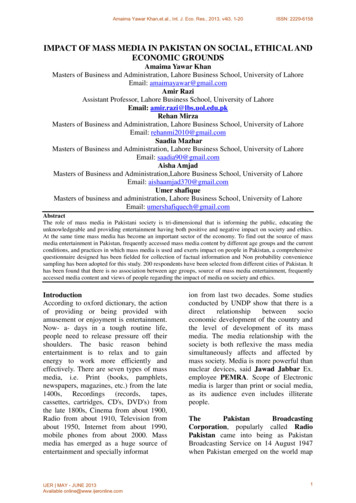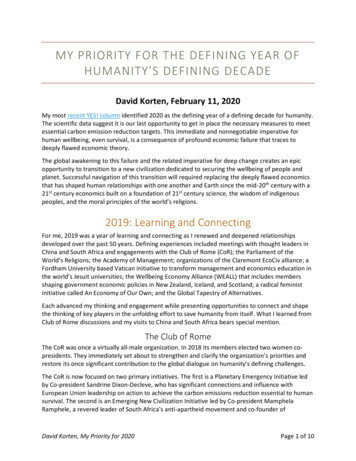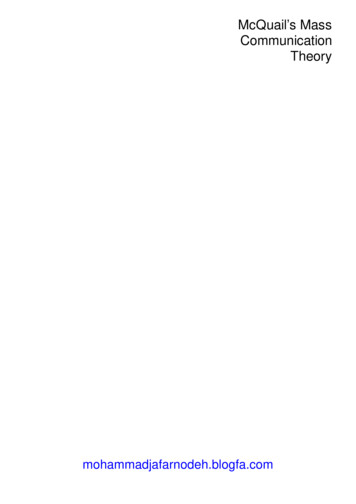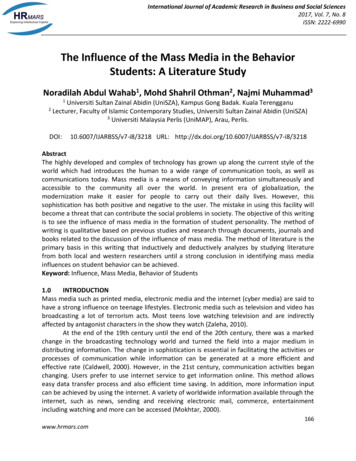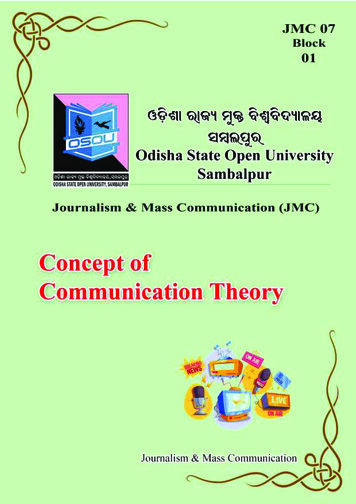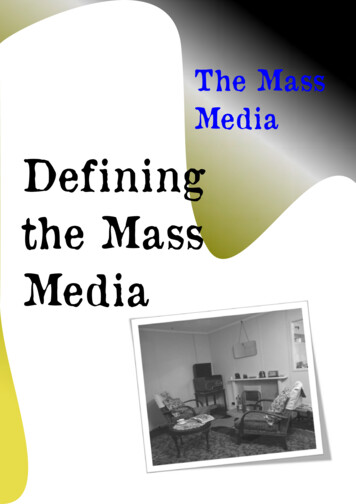
Transcription
The MassMediaDefiningthe MassMedia
Defining theMass MediaThe focus of this openingsection is an examinationof different explanationsof the relationshipbetween ownership andcontrol of the mass mediaand, in order to do this,we need to begin bythinking about how themass media can bedefined.Breaking down the concept of a ‘mass media’ into itsconstituent parts.A medium is a ‘channel of communication’ - a meansthrough which people send and receive information. Theprinted word, for example, is a medium; when we read anewspaper or magazine, something is communicated to usin some way. Similarly, electronic forms of communication television, telephones, film and such like - are media (theplural of medium). Mass, as you probably realise, means‘many’ and what we are interested in here is how and whydifferent forms of media are used to transmit to – and bereceived by – large numbers of people (the audience).ObservationsMass media, therefore, refer to channels of communicationthat involve transmitting information in some way, shape orform to large numbers of people (although the question ofexactly how many a “large number” has to be to qualify as a“mass” is something that’s generally left undefined - it’s one ofthose things that we know when we see it.).A mass medium (such as television) is generally classified as‘one-to-many’ communication - ‘one’ person (such as the authorof a book, the creators of a television programme or a film director),communicates to many people (the audience) “at the same time” in away that is largely impersonal; that is, the communication is one-way,in the sense that those communicating a message to an audiencedon’t receive simultaneous feedback from that audience (you canshout at a politician on the television but they can’t hear you.).Dutton et al (1998) suggest that, traditionally (animportant qualification that will be developed further in amoment), the mass media has been differentiated fromother types of communication (such as interpersonalcommunication that occurs on a one-to-one basis) interms of four essential characteristics:1. Distance: Communication between those who sendand receive messages (media-speak for information) is:ü impersonal,ü lacks immediacy and isü one way (from the producer/creator of theinformation to the consumer / audience).When I watch a film, for example, no matter howemotionally involved I become in the action, I can’tdirectly affect what’s unfolding on the screen.2. Technology: Mass communication requires avehicle, such as a television receiver, a method ofprinting and so forth, that allows messages to be sentand received.3. Scale: One feature of a mass medium, as we’venoted, is it involves simultaneous communication withmany people; for example, as I sit in my living roomwatching Chelsea play Manchester United on TV, the1same behaviour is being reproduced in thousands ofother living rooms, not just across the country but also, inthis instance, across the globe.4. Commodity: An interesting feature of masscommunication is that it comes at a price. I can watchfootball on TV, for example, if I can afford a television, alicense fee (to watch BBC or ITV) or a subscription tosomething like Sky Sports if it’s on satellite or cable.
We no-longer live in asociety where it's possibleto make a clear andobvious distinction betweenthose (mass) media thatsimply involve one-to-manycommunication and those(non-mass) media thatmerely involve one-to-onecommunication.ExplanationsAlthough the definition we've just put forward serves thenot unhelpful purpose of introducing the basic idea of amass medium, its usefulness as a definition for ourcurrent purpose is somewhat limited - mainly because, asyou may have noticed, while it's reasonably easy to usethis definition to identify a range of mass media (books,television, film and so forth) the world, as it were, hasmoved on.We no-longer live in a society where it's possible to makea clear and obvious distinction between those (mass)media that simply involve one-to-many communicationand those (non-mass) media that merely involve one-toone communication. In recent times, for example, we'veseen the development of forms of communication (suchas mobile phones and email) that don’t fit easily (if at all)into traditional definitions, mainly because they have thecapacity to be both: interpersonal (‘one-to-one’) communication and mass (‘one-to-many’) communication.2In defining the mass media, therefore, we've encountereda problem that, as recently as 25 years ago, wouldn’thave been a problem; namely, the development ofcomputer networks.Depending on how it's used, for example, email caninvolve exchanging interpersonal messages with friendsand family (‘Hi, how are you?’) or sending one messageto many thousands, if not millions, of people; customersof on-line retailers, such as Amazon for example, canrequest email notification of special offers and so forth.Unrequested mass emailing (or "spam") also comes intothis category.Although peer-to-peer networks involve communicationbetween large numbers of people, a not insignificantfeature of these networks is that they reverse theaccepted wisdom about a mass medium in the sense thatthey represent "many-to-one" communication; largenumbers of people effectively cooperate to deliver aThe ability to link computer technology (to createsomething like the Internet or mobile phone networks) has message (such as a song) to an individual (who, in turn,created a subtle - but incredibly important - change in the may choose to cooperate as part of the network toway we both define and conceptualise the mass media.transmit that message to everyone else in the networkwho wants it).To make matters even more complicated, computernetworks open up the potential for ‘many-to-many’communication, where a mass audience can,Social network media, such as Bebo, MySpace orsimultaneously, interact and communicate with eachprobably the most important and influential social networkother. Something that, in other words, represents a mass currently (2011) in existence - Facebook. These types ofmedium based on interpersonal communication. To clarify social media allow various forms of communication (onethis idea, think about things like:to-one, many-to-one, one-to-many, many-to-many.)depending on how the individual decides or chooses toInternet chatrooms: These conform to three of thecommunicate.components of a ‘mass medium’ we’ve identified (scale,technology and commodity). However, ‘distance’ is aproblem because a chatroom, for example, cansimultaneously involve one-to-one, one-to-many andmany-to-many communication.Peer-to-peer networks use software to link individualcomputers, such that anyone connected to the networkcan exchange information directly with anyone else. In theworkplace, for example, this can mean any number ofpeople can contribute to the same piece of work at thesame time. As is the way of such things, this type ofnetwork can also be used illegally to breech copyrightlaws through the sharing of music, films and books.
Imagine visiting anewspaper websiteand seeing not justthe bulletins andmajor stories youwouldn’t have knownabout, but also therest of that editioncustomized to yourunique needs andinterests.In the light of these (and many other - video-sharing,blogging and the like) developments, therefore, we need torethink and redefine the concept of the mass media bycreating a distinction between:Old (or traditional) mass media, such as television, booksand magazines, that involve ‘one-to many’ communication,based on a one-way process of producers creatinginformation that is transmitted to large numbers ofconsumers, and:New mass media, such as peer-to-peer networks, involving‘many-to-many’ communication based on two-waycommunication with participants as both producers andconsumers of information. ‘New’ forms of mass media caninvolve two-way communication within a mass audience whoare both producers and consumers.A further dimension to these forms of communication thatmark them apart from traditional forms of mass media,therefore, is that some new media clearly blur the traditionaldistinction between producer and consumer - an importantidea we will need to develop at some point.However, for the moment it's enough to note that whereas inthe past traditional forms of mass media were based squarelyon a hard-and-fast distinction between those who producedthe media and those who consumed it (something that still, ofcourse, exists when you read a book, watch television or go tothe cinema), new forms of mass media don't necessarilyconfirm to this easy distinction.When you take part in a conversation in a chatroom orforum, for example, you are both the produced and theconsumer of information - and while this may not seemlike a particularly important or stunning revelation it hashugely important ramifications for our understanding ofother aspects of the mass media such as the relationshipbetween media producers and their audience (adiscussion we'll leave to a later point).For the moment we can note that Crosbie (2002) arguesthat new (mass) media have characteristics that, whencombined, make them very different to other forms ofmass media. These include:Technology: They cannot exist withoutthe appropriate d messages(either tailored to the particularneeds of those receiving themor having the appearance ofbeing so constructed) can besimultaneously delivered to vastnumbers of people.Collective control: Each person in anetwork has, potentially, the ability to share,shape and change the content of the information beingexchanged.3Crosbie uses the following example to illustrate thisidea:“Imagine visiting a newspaper website and seeing notjust the bulletins and major stories you wouldn’t haveknown about, but also the rest of that editioncustomized to your unique needs and interests. Ratherthan every reader seeing the same edition, each readersees an edition simultaneously individualized to theirinterests and generalized to their needs”.
Crosbie, Vin, 2002, ‘What Is New Media?’:Digital Deliverance: www.digitaldeliverance.comReferences4Dutton, Brian, O’Sullivan, Tim and Rayne,Phillip, 1998, Studying the Media: Arnold
Designandwords:Chris. Livesey Sociology Central, 2011www.sociology.org.uk
this definition to identify a range of mass media (books, television, film and so forth) the world, as it were, has moved on. We no-longer live in a society where it's possible to make a clear and obvious distinction between those (mass) media that simply involve one-to-many communication and those (non

